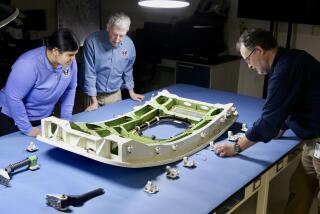In-Flight Inspections Missed Shuttle Damage
- Share via
CAPE CANAVERAL, Fla. — A piece of space debris punched a small hole in one of the space shuttle Atlantis’ radiator panels during its recent 12-day spaceflight, NASA said Thursday.
Damage from debris has been NASA’s top safety issue since the destruction of the shuttle Columbia in February 2003, when insulating foam came off the ship’s fuel tank during launch and punched a hole in the shuttle’s heat shield.
The radiator damage, which measures slightly more than one-tenth of an inch in diameter, was found during routine post-landing inspections at the Kennedy Space Center in Florida, NASA spokeswoman Jessica Rye said.
Atlantis landed safely Sept. 21, after the damage had gone undetected in three intensive inspections during its flight.
Those assessments focused on the shuttle’s heat shield, and though the radiator is a critical system, the metal panels are not exposed during the ship’s fiery plunge through the Earth’s atmosphere for landing.
The panels unfold from the payload bay doors to cool the ship during flight.
“Radiators are potentially dangerous because they affect life-support systems and temperature controls,” said William Schonberg, a space debris researcher and a civil engineering professor at the University of Missouri-Rolla.
Since losing Columbia, NASA has developed a suite of instruments to assess how well the shuttles fared during the supersonic climb to orbit.
Columbia was destroyed and its seven crew members killed because a piece of foam fell off the fuel tank during launch and hit the wing, breaking a hole in its heat shield.
As the shuttle flew through the atmosphere for landing, superheated gases tore into the breach and ripped the ship apart.
In addition to employing in-flight inspections to check for damage during launch, NASA redesigned the faulty tank and equipped the International Space Station as an emergency shelter in case another shuttle should suffer Columbia-like damage.
NASA last year also mandated an inspection late in each mission to check for damage from tiny meteoroids.
After seeing debris flying in the vicinity of the shuttle, NASA postponed Atlantis’ homecoming a day to conduct a second survey.
It was not known if the radiator panel damage was related to the flyaway objects.
More to Read
Sign up for Essential California
The most important California stories and recommendations in your inbox every morning.
You may occasionally receive promotional content from the Los Angeles Times.













